oil CHEVROLET DURAMAX 2006 Owners Manual
[x] Cancel search | Manufacturer: CHEVROLET, Model Year: 2006, Model line: DURAMAX, Model: CHEVROLET DURAMAX 2006Pages: 100, PDF Size: 0.71 MB
Page 5 of 100
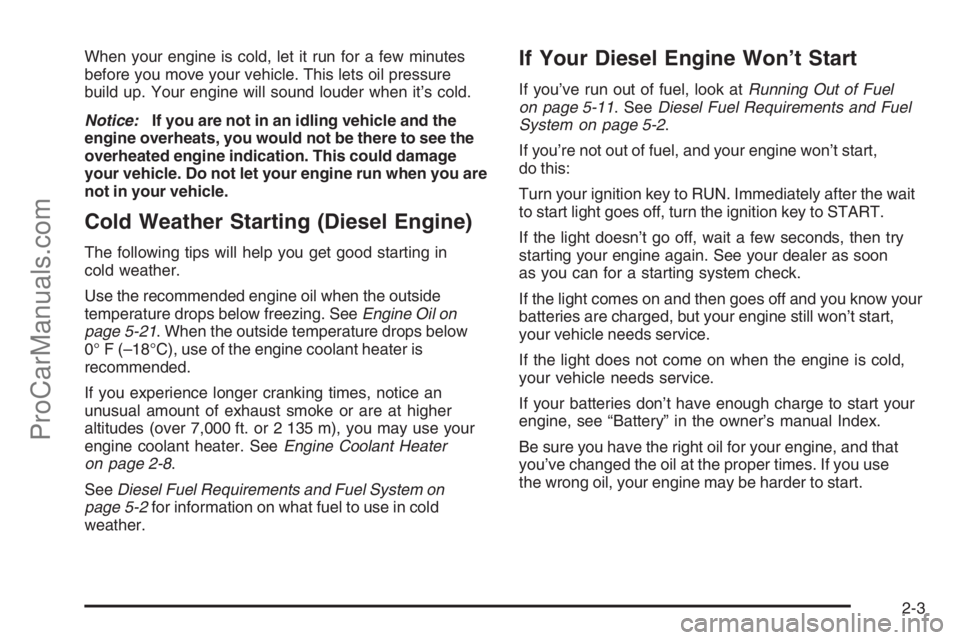
When your engine is cold, let it run for a few minutes
before you move your vehicle. This lets oil pressure
build up. Your engine will sound louder when it’s cold.
Notice:If you are not in an idling vehicle and the
engine overheats, you would not be there to see the
overheated engine indication. This could damage
your vehicle. Do not let your engine run when you are
not in your vehicle.
Cold Weather Starting (Diesel Engine)
The following tips will help you get good starting in
cold weather.
Use the recommended engine oil when the outside
temperature drops below freezing. SeeEngine Oil on
page 5-21. When the outside temperature drops below
0° F (–18°C), use of the engine coolant heater is
recommended.
If you experience longer cranking times, notice an
unusual amount of exhaust smoke or are at higher
altitudes (over 7,000 ft. or 2 135 m), you may use your
engine coolant heater. SeeEngine Coolant Heater
on page 2-8.
SeeDiesel Fuel Requirements and Fuel System on
page 5-2for information on what fuel to use in cold
weather.
If Your Diesel Engine Won’t Start
If you’ve run out of fuel, look atRunning Out of Fuel
on page 5-11. SeeDiesel Fuel Requirements and Fuel
System on page 5-2.
If you’re not out of fuel, and your engine won’t start,
do this:
Turn your ignition key to RUN. Immediately after the wait
to start light goes off, turn the ignition key to START.
If the light doesn’t go off, wait a few seconds, then try
starting your engine again. See your dealer as soon
as you can for a starting system check.
If the light comes on and then goes off and you know your
batteries are charged, but your engine still won’t start,
your vehicle needs service.
If the light does not come on when the engine is cold,
your vehicle needs service.
If your batteries don’t have enough charge to start your
engine, see “Battery” in the owner’s manual Index.
Be sure you have the right oil for your engine, and that
you’ve changed the oil at the proper times. If you use
the wrong oil, your engine may be harder to start.
2-3
ProCarManuals.com
Page 13 of 100
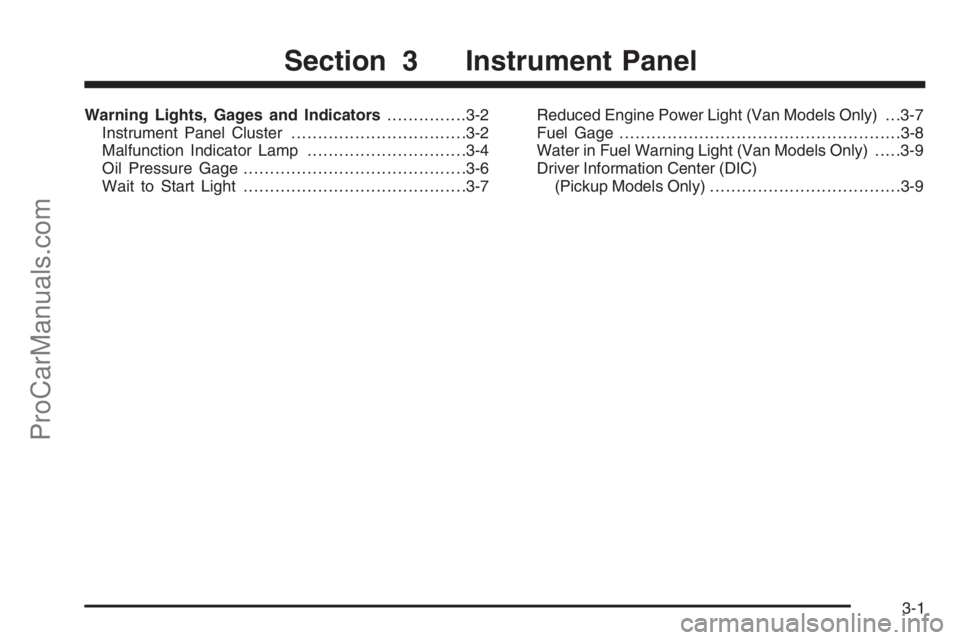
Warning Lights, Gages and Indicators...............3-2
Instrument Panel Cluster.................................3-2
Malfunction Indicator Lamp..............................3-4
Oil Pressure Gage..........................................3-6
Wait to Start Light..........................................3-7Reduced Engine Power Light (Van Models Only) . . .3-7
Fuel Gage.....................................................3-8
Water in Fuel Warning Light (Van Models Only).....3-9
Driver Information Center (DIC)
(Pickup Models Only)....................................3-9
Section 3 Instrument Panel
3-1
ProCarManuals.com
Page 18 of 100
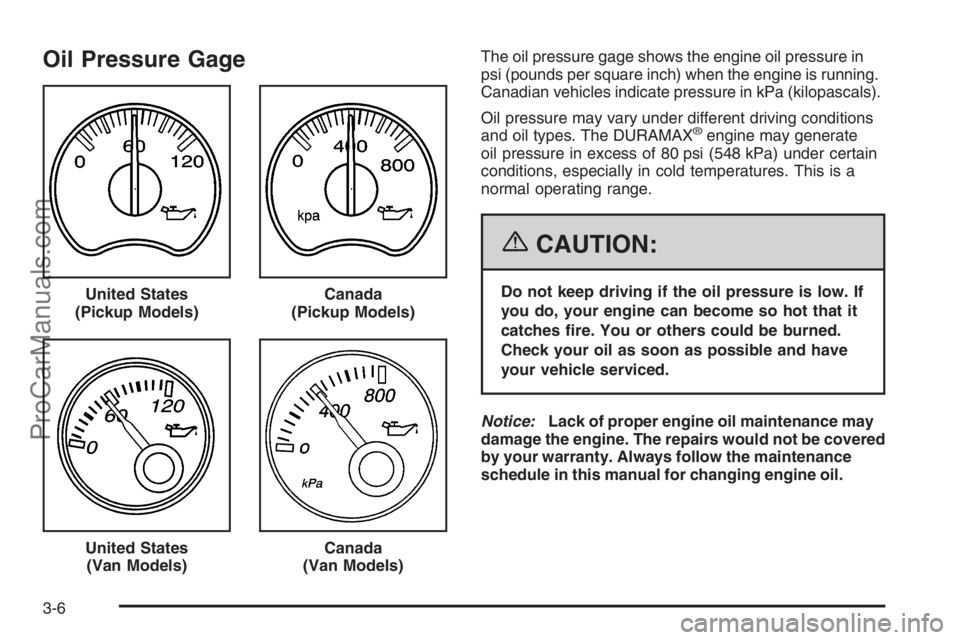
Oil Pressure GageThe oil pressure gage shows the engine oil pressure in
psi (pounds per square inch) when the engine is running.
Canadian vehicles indicate pressure in kPa (kilopascals).
Oil pressure may vary under different driving conditions
and oil types. The DURAMAX
®engine may generate
oil pressure in excess of 80 psi (548 kPa) under certain
conditions, especially in cold temperatures. This is a
normal operating range.
{CAUTION:
Do not keep driving if the oil pressure is low. If
you do, your engine can become so hot that it
catches �re. You or others could be burned.
Check your oil as soon as possible and have
your vehicle serviced.
Notice:Lack of proper engine oil maintenance may
damage the engine. The repairs would not be covered
by your warranty. Always follow the maintenance
schedule in this manual for changing engine oil. United States
(Pickup Models)Canada
(Pickup Models)
United States
(Van Models)Canada
(Van Models)
3-6
ProCarManuals.com
Page 24 of 100
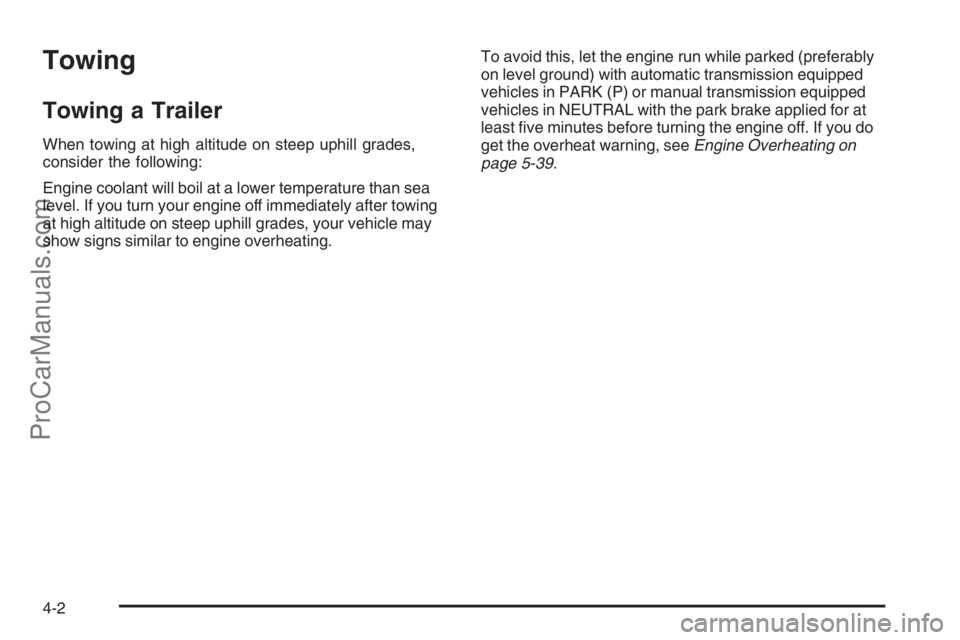
Towing
Towing a Trailer
When towing at high altitude on steep uphill grades,
consider the following:
Engine coolant will boil at a lower temperature than sea
level. If you turn your engine off immediately after towing
at high altitude on steep uphill grades, your vehicle may
show signs similar to engine overheating.To avoid this, let the engine run while parked (preferably
on level ground) with automatic transmission equipped
vehicles in PARK (P) or manual transmission equipped
vehicles in NEUTRAL with the park brake applied for at
least five minutes before turning the engine off. If you do
get the overheat warning, seeEngine Overheating on
page 5-39.
4-2
ProCarManuals.com
Page 25 of 100
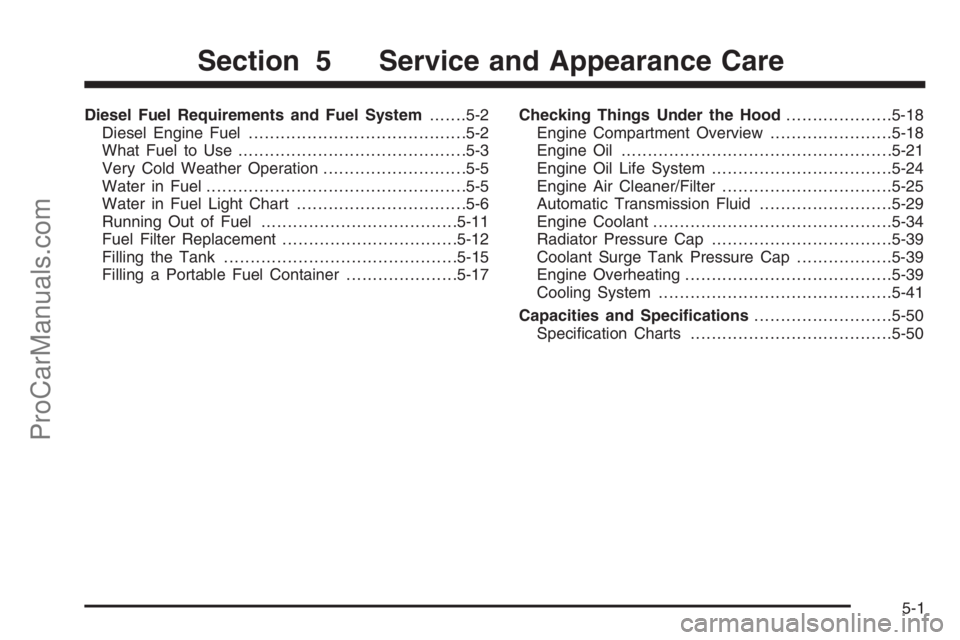
Diesel Fuel Requirements and Fuel System.......5-2
Diesel Engine Fuel.........................................5-2
What Fuel to Use...........................................5-3
Very Cold Weather Operation...........................5-5
Water in Fuel.................................................5-5
Water in Fuel Light Chart................................5-6
Running Out of Fuel.....................................5-11
Fuel Filter Replacement.................................5-12
Filling the Tank............................................5-15
Filling a Portable Fuel Container.....................5-17Checking Things Under the Hood....................5-18
Engine Compartment Overview.......................5-18
Engine Oil...................................................5-21
Engine Oil Life System..................................5-24
Engine Air Cleaner/Filter................................5-25
Automatic Transmission Fluid.........................5-29
Engine Coolant.............................................5-34
Radiator Pressure Cap..................................5-39
Coolant Surge Tank Pressure Cap..................5-39
Engine Overheating.......................................5-39
Cooling System............................................5-41
Capacities and Speci�cations..........................5-50
Specification Charts......................................5-50
Section 5 Service and Appearance Care
5-1
ProCarManuals.com
Page 26 of 100
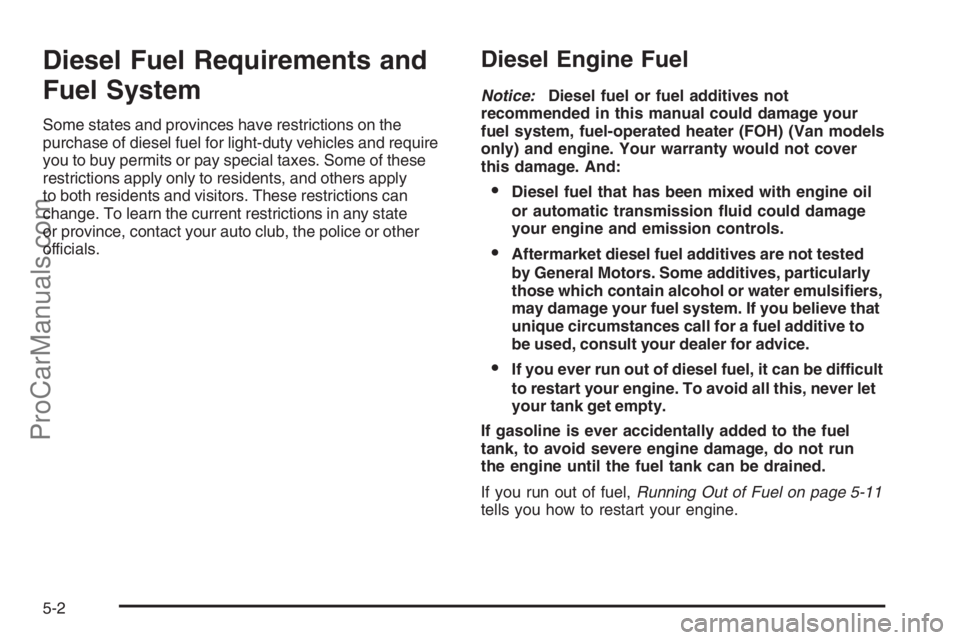
Diesel Fuel Requirements and
Fuel System
Some states and provinces have restrictions on the
purchase of diesel fuel for light-duty vehicles and require
you to buy permits or pay special taxes. Some of these
restrictions apply only to residents, and others apply
to both residents and visitors. These restrictions can
change. To learn the current restrictions in any state
or province, contact your auto club, the police or other
officials.
Diesel Engine Fuel
Notice:Diesel fuel or fuel additives not
recommended in this manual could damage your
fuel system, fuel-operated heater (FOH) (Van models
only) and engine. Your warranty would not cover
this damage. And:
Diesel fuel that has been mixed with engine oil
or automatic transmission �uid could damage
your engine and emission controls.
Aftermarket diesel fuel additives are not tested
by General Motors. Some additives, particularly
those which contain alcohol or water emulsi�ers,
may damage your fuel system. If you believe that
unique circumstances call for a fuel additive to
be used, consult your dealer for advice.
If you ever run out of diesel fuel, it can be difficult
to restart your engine. To avoid all this, never let
your tank get empty.
If gasoline is ever accidentally added to the fuel
tank, to avoid severe engine damage, do not run
the engine until the fuel tank can be drained.
If you run out of fuel,Running Out of Fuel on page 5-11
tells you how to restart your engine.
5-2
ProCarManuals.com
Page 27 of 100
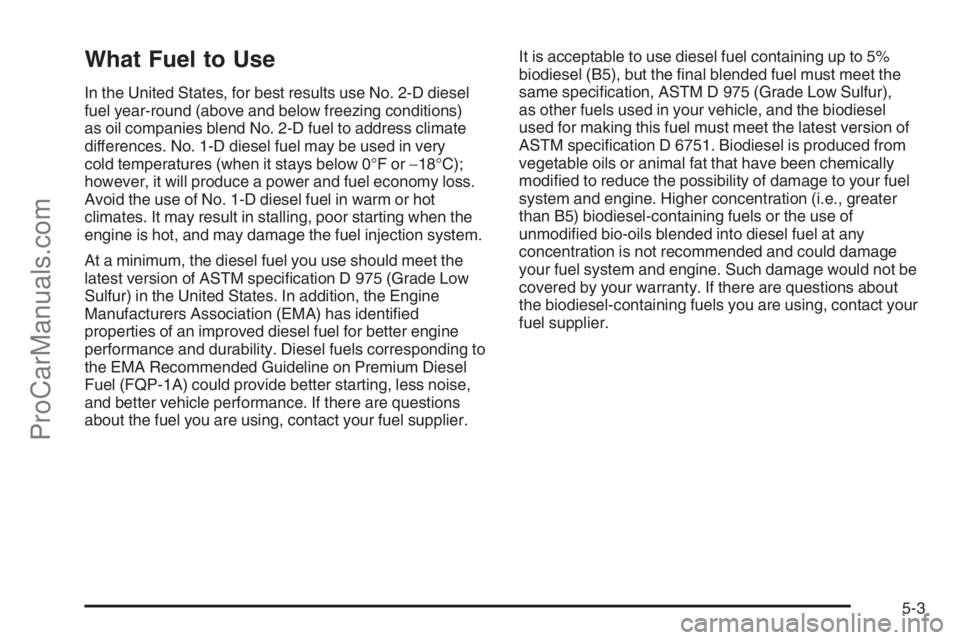
What Fuel to Use
In the United States, for best results use No. 2-D diesel
fuel year-round (above and below freezing conditions)
as oil companies blend No. 2-D fuel to address climate
differences. No. 1-D diesel fuel may be used in very
cold temperatures (when it stays below 0°F or−18°C);
however, it will produce a power and fuel economy loss.
Avoid the use of No. 1-D diesel fuel in warm or hot
climates. It may result in stalling, poor starting when the
engine is hot, and may damage the fuel injection system.
At a minimum, the diesel fuel you use should meet the
latest version of ASTM specification D 975 (Grade Low
Sulfur) in the United States. In addition, the Engine
Manufacturers Association (EMA) has identified
properties of an improved diesel fuel for better engine
performance and durability. Diesel fuels corresponding to
the EMA Recommended Guideline on Premium Diesel
Fuel (FQP-1A) could provide better starting, less noise,
and better vehicle performance. If there are questions
about the fuel you are using, contact your fuel supplier.It is acceptable to use diesel fuel containing up to 5%
biodiesel (B5), but the final blended fuel must meet the
same specification, ASTM D 975 (Grade Low Sulfur),
as other fuels used in your vehicle, and the biodiesel
used for making this fuel must meet the latest version of
ASTM specification D 6751. Biodiesel is produced from
vegetable oils or animal fat that have been chemically
modified to reduce the possibility of damage to your fuel
system and engine. Higher concentration (i.e., greater
than B5) biodiesel-containing fuels or the use of
unmodified bio-oils blended into diesel fuel at any
concentration is not recommended and could damage
your fuel system and engine. Such damage would not be
covered by your warranty. If there are questions about
the biodiesel-containing fuels you are using, contact your
fuel supplier.
5-3
ProCarManuals.com
Page 29 of 100
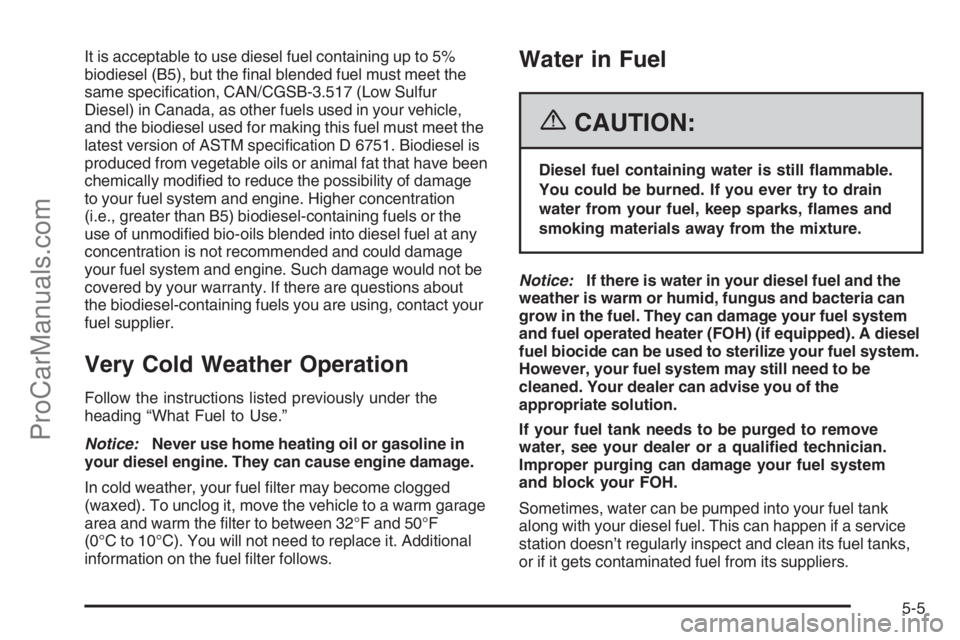
It is acceptable to use diesel fuel containing up to 5%
biodiesel (B5), but the final blended fuel must meet the
same specification, CAN/CGSB-3.517 (Low Sulfur
Diesel) in Canada, as other fuels used in your vehicle,
and the biodiesel used for making this fuel must meet the
latest version of ASTM specification D 6751. Biodiesel is
produced from vegetable oils or animal fat that have been
chemically modified to reduce the possibility of damage
to your fuel system and engine. Higher concentration
(i.e., greater than B5) biodiesel-containing fuels or the
use of unmodified bio-oils blended into diesel fuel at any
concentration is not recommended and could damage
your fuel system and engine. Such damage would not be
covered by your warranty. If there are questions about
the biodiesel-containing fuels you are using, contact your
fuel supplier.
Very Cold Weather Operation
Follow the instructions listed previously under the
heading “What Fuel to Use.”
Notice:Never use home heating oil or gasoline in
your diesel engine. They can cause engine damage.
In cold weather, your fuel filter may become clogged
(waxed). To unclog it, move the vehicle to a warm garage
area and warm the filter to between 32°F and 50°F
(0°C to 10°C). You will not need to replace it. Additional
information on the fuel filter follows.
Water in Fuel
{CAUTION:
Diesel fuel containing water is still �ammable.
You could be burned. If you ever try to drain
water from your fuel, keep sparks, �ames and
smoking materials away from the mixture.
Notice:If there is water in your diesel fuel and the
weather is warm or humid, fungus and bacteria can
grow in the fuel. They can damage your fuel system
and fuel operated heater (FOH) (if equipped). A diesel
fuel biocide can be used to sterilize your fuel system.
However, your fuel system may still need to be
cleaned. Your dealer can advise you of the
appropriate solution.
If your fuel tank needs to be purged to remove
water, see your dealer or a quali�ed technician.
Improper purging can damage your fuel system
and block your FOH.
Sometimes, water can be pumped into your fuel tank
along with your diesel fuel. This can happen if a service
station doesn’t regularly inspect and clean its fuel tanks,
or if it gets contaminated fuel from its suppliers.
5-5
ProCarManuals.com
Page 32 of 100
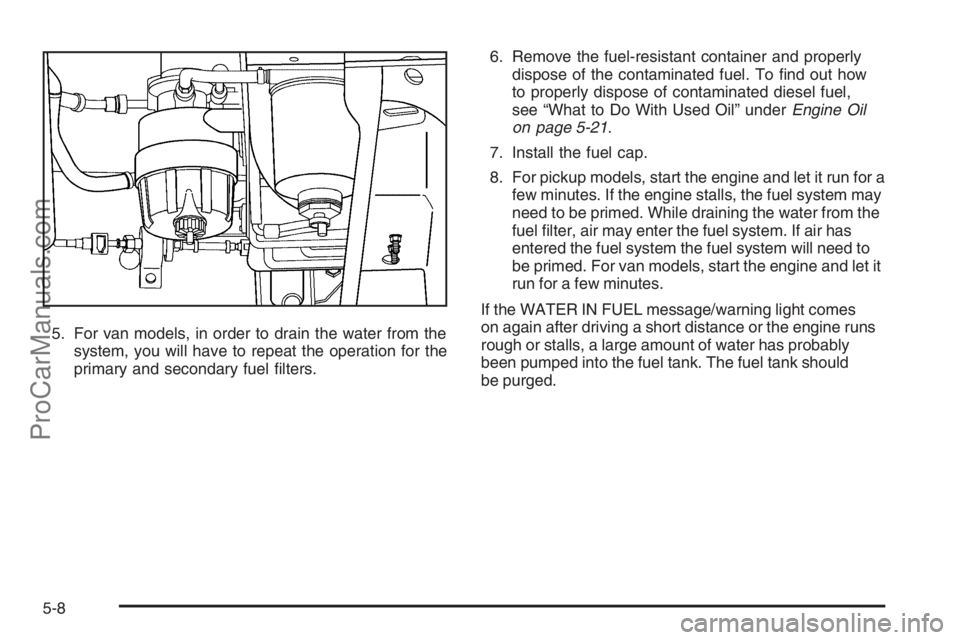
5. For van models, in order to drain the water from the
system, you will have to repeat the operation for the
primary and secondary fuel filters.6. Remove the fuel-resistant container and properly
dispose of the contaminated fuel. To find out how
to properly dispose of contaminated diesel fuel,
see “What to Do With Used Oil” underEngine Oil
on page 5-21.
7. Install the fuel cap.
8. For pickup models, start the engine and let it run for a
few minutes. If the engine stalls, the fuel system may
need to be primed. While draining the water from the
fuel filter, air may enter the fuel system. If air has
entered the fuel system the fuel system will need to
be primed. For van models, start the engine and let it
run for a few minutes.
If the WATER IN FUEL message/warning light comes
on again after driving a short distance or the engine runs
rough or stalls, a large amount of water has probably
been pumped into the fuel tank. The fuel tank should
be purged.
5-8
ProCarManuals.com
Page 43 of 100
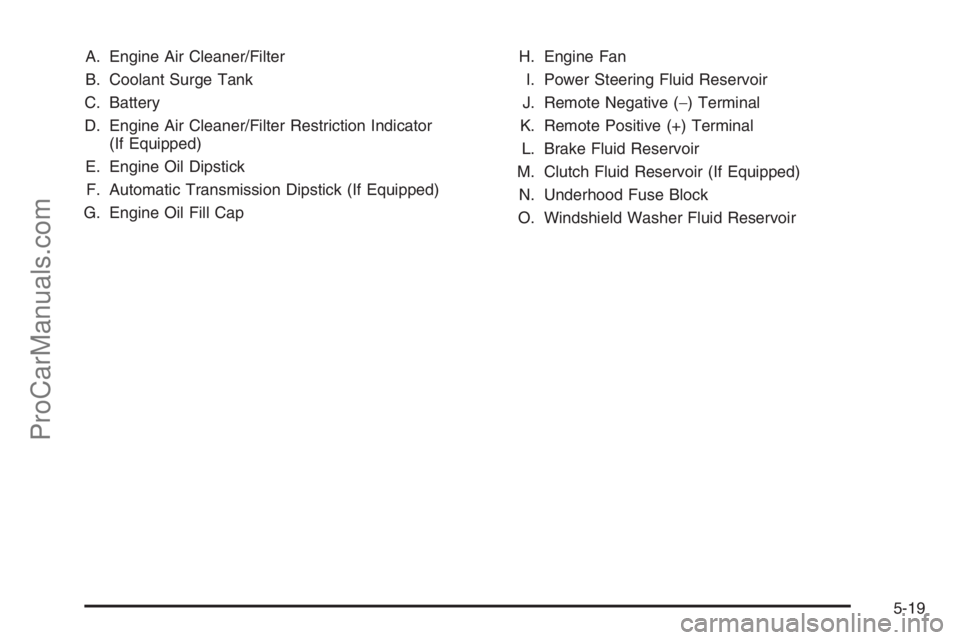
A. Engine Air Cleaner/Filter
B. Coolant Surge Tank
C. Battery
D. Engine Air Cleaner/Filter Restriction Indicator
(If Equipped)
E. Engine Oil Dipstick
F. Automatic Transmission Dipstick (If Equipped)
G. Engine Oil Fill CapH. Engine Fan
I. Power Steering Fluid Reservoir
J. Remote Negative (−) Terminal
K. Remote Positive (+) Terminal
L. Brake Fluid Reservoir
M. Clutch Fluid Reservoir (If Equipped)
N. Underhood Fuse Block
O. Windshield Washer Fluid Reservoir
5-19
ProCarManuals.com